What I expected to be a boring afternoon, freezing in a claustrophobic hut, turned out to be an anomalous but pleasant way to spend four hours on a Sunday.
The possibility of going ice fishing first came to my attention when I stumbled upon the organization Pêche Blanche, located in the Old Port. The notion of doing an activity I associated with a bunch of plaid-clad men and pristine lakes surrounded by snow-covered white pines, in the midst of bustling downtown Montreal caught me off guard. When a friend proposed the idea, there was no way I was going to pass up the opportunity.
The fishing village is located off the docks of the Montreal Yacht Club. The setup was comfortable and convenient; the basic wood structure could easily seat about eight people and was equipped with two space heaters to keep us warm all afternoon. Openings cut into the floor exposed the holes in the ice below. The rods were placed so that we only had to check them occasionally.
An employee instructed us on how to fish—from attaching bait to reeling in—only to be interrupted by the jerking of one of the rods. We were giddy and eager to reel in the fish, but were more shocked that there were fish actually biting at our rods. Up until that moment, we had doubts that it would be possible to catch anything so close to home. The fish didn’t hook, but we were stricken with high hopes of an action-packed afternoon.
Within five minutes of settling in, we were questioning why we hadn’t brought a deck of cards, or at least downloaded the app Heads Up on one of our iPhones. We passed the time naming the minnows in our bait bucket, snacking, and talking about television. We waited impatiently like children on Christmas morning. Over the course of the afternoon, there was only a handful of nibbles; each time we immediately fell silent until the fish inevitably swam away.
Finally, after three and and half hours, a fish finally caught on the hook. As we reeled in, the fish became visible in the hole; its bulging eyes and gaping mouth emerged from the water. In a true reflection of our generation’s attachment to social media, five of us whipped out our phones and huddled around the hole snapping photos of the floundering fish below. We may have been more excited to capture the perfect Kodak moment than to have caught the fish.
The line snagged and we couldn’t pull the fish any further. In a panic we reached for whatever long pole was available in the hut and tried to release whatever was caught. Like a fish out of water we were hopeless and required expert assistance; a deft employee unhooked the fish within the hole and then freed the hook from the ice.
His enthusiasm for our fish—a Sauger, the largest catch of the day—and for amateur photography matched our own; we were taken outside for a photo shoot with our fish, which was promptly uploaded to Pêche Blanche’s Facebook page.
Despite concerns about the contaminants in the fish from the shores of a polluted urban metropolis, the most surreal part of the experience was finally eating our catch. With live fish in hand, we hopped in a cab back home and used YouTube to guide the gutting process. As far as local food goes, this was about as local as it could get; it’s rare to know where your food comes from, nevermind being the one to actually catch it.
With the whole afternoon costing around $40 each for fishing licenses and rental fees, it was the freshest and most expensive fish I’ve ever eaten. The once-in-a-lifetime, oddly commercialized, back-to-nature experience was nonetheless priceless.








